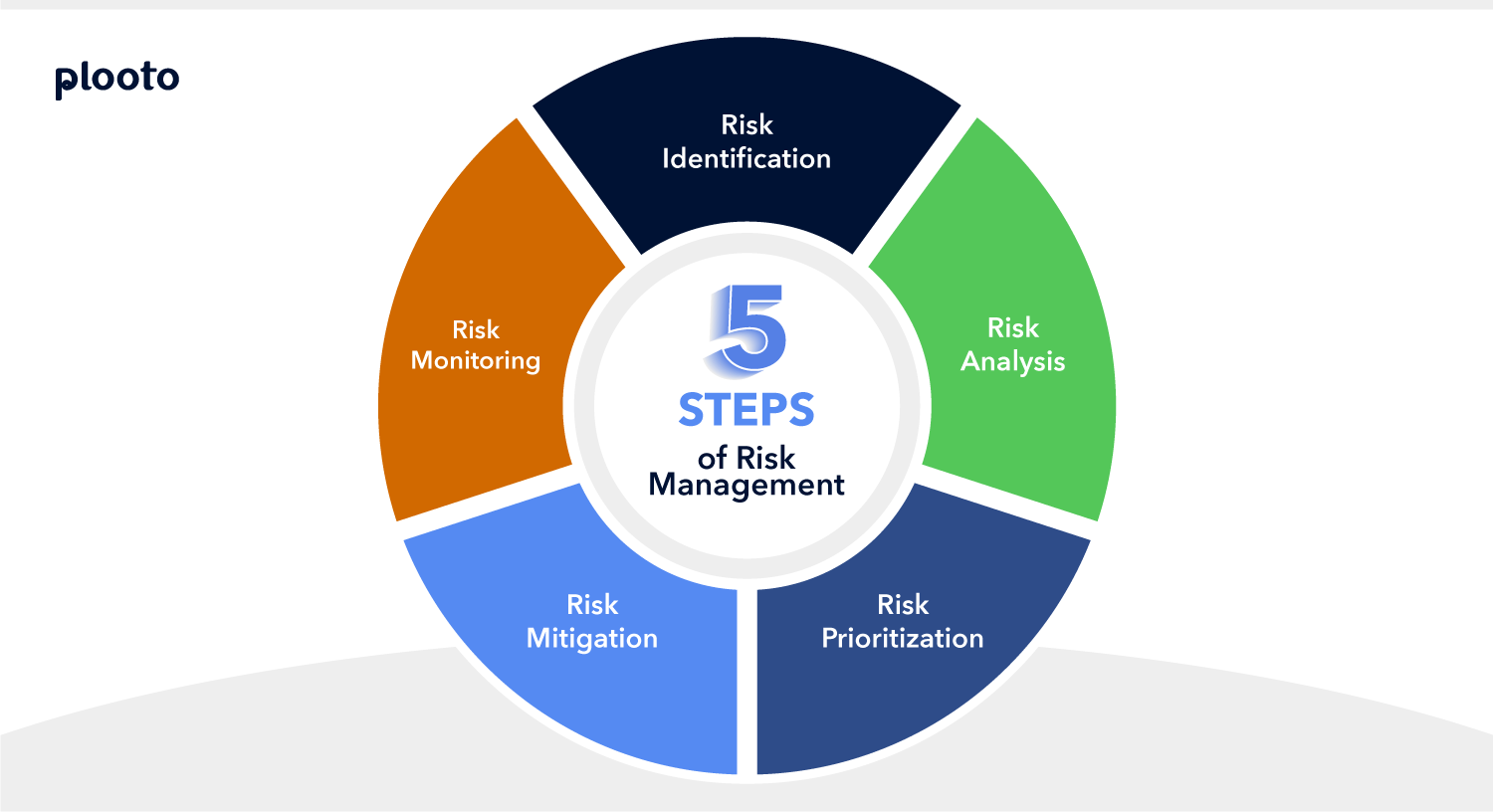
Doing business means coming face-to-face with risk. As your business grows within the market, it’s impossible to not be impacted by risk. Developing a risk management plan that helps your business swiftly recover and manage risks is crucial to maintaining business longevity.
Keep reading to learn how risk management can improve your business.
SHORTCUTS
- What does risk management involve?
- What are the key components of a risk management plan?
- Why is it so critical to have a risk management strategy?
- What are the essential techniques of risk management?
- The risk analysis process
- Benefits of risk management
- Risk management limitations
- Ways to mitigate risk in finance
- Risk management best practices
- Risk management strategies to follow in finance
- How to build and implement a risk management plan?
- Risk management solutions
What does risk management involve?
Risk management involves all the processes and procedures to identify, assess, monitor, and respond to risks. It addresses the strategies companies use when approaching risks and outlines the responsibilities associated with managing and reacting to risk.
An important aspect of risk management is identifying risks and adding them to a risk register. A risk register is a live document that lists known risks and ranks the possible severity and likelihood of them occurring. This helps teams deal with risks proactively and develop responses before risks occur.
Risks are divided into three categories:
- Preventable
- These are internal risks that can be controlled and eliminated.
- They are best managed through active prevention and the creation of policies/rules.
- Strategic
- These are risks that a business will choose to take to generate a return.
- Best to have a risk management system in place to manage and contain the risks taken.
- External
- These risks are out of the control of the company and need to be closely monitored.
- Ideal to have responses and processes proactively planned to deal with external risks.

What are the key components of a risk management plan?
A risk management plan includes planning and procedures for:
Risk identification
Your risk management plan should detail how and when risks will be identified. Your plan should outline:
- Who is responsible for identifying internal and external risks to the business?
- How will risks be identified?
- Who will update the risk register and keep it organized?
- Will you use analysis software to help and/or hire outside expertise?
Risk analysis
The risk register should note the level of possible impact on the business and the probability of the risk occurring. Your plan should detail:
- How will risks be analyzed?
- What tools and/or expertise will be utilized to analyze risk?
- How will you measure the likelihood and severity of risk, as well as categorize them?
Risk prioritization
Depending on the possible impact of risks and the likelihood of them occurring risks should be prioritized by business objectives. This way resources can be optimally used to manage risks. For prioritizing risks:
- Develop a plan for each risk to either: avoid, accept, mitigate, or transfer.
- Use hypothetical scenarios to plan how the risk could play out and how the business could respond.
Risk mitigation
Risk mitigation outlines the plan for when risks will impact the business. It aims to dampen the impact of the event and/or how to transfer or absorb it. With risk prioritization, your team can create detailed risk mitigation plans for the most important risks, while still preparing for all potential risks.
Risk monitoring
Risk monitoring helps identify risks and know when to start responding to them. Additionally, continuously monitoring risks for changes is important for updating the assessment of risks in the risk register. Once risks have been responded to, it's important to monitor the results of the response and assess how the plan lessened the impact.

Why is it so critical to have a risk management strategy?
Developing a risk management strategy is crucial to prepare your business for uncertain events and for lessening the negative impact of taking on risks. It also allows you to identify positive risks to take on to enhance the business.
A risk management strategy helps:
- Operational effectiveness and business continuity
- Protect your company's assets
- Customer satisfaction and loyalty
- Realize benefits and achieve goals
- Increase profitability
What are the essential techniques of risk management?
There are five basic techniques of risk management:
Avoidance
This technique occurs when risks are eliminated and/or avoided altogether. Avoidance of risks can be enabled through internal policies, due diligence, re-negotiations and/or choosing not to participate.
Retention
Retention is used when taking some or all the risk. This strategy can be used when attempting to take on risk in the present to offset future risks, or when the business can absorb the cost with little impact.
Spreading
This technique is used to spread the risk of loss across different parties. For example, taking on partnerships spreads risk onto two parties instead of just one.
Transferring
Transferring risk is achieved by passing the risk to another party - like purchasing insurance or entering into contracts.
Loss Prevention and Reduction
When an event occurs that could not be avoided, transferred, or effectively retained, loss prevention must go into effect to minimize loss. Previous planning and risk prediction can aid in developing practical plans to reduce losses.
The risk analysis process
1. Identify existing risks
The first step to risk analysis is identifying potential risks to the business and documenting them.
2. Assess the risks
Next, the listed risks must be assessed on their likelihood and the level of impact. The risks can then be prioritized.
3. Develop an appropriate response
Appropriate responses should be developed for the risks, with more effort expensed to the prioritized risks.
4. Develop preventive mechanisms for identified risks
Lastly, create preventive measures for risks, as to dampen possible impacts or to lessen the possibility of the event occurring.
Benefits of risk management
- Opportunity to find positive risks to take on.
- Better prepared for negative situations.
- Fewer surprises.
- Better project projection.
- Greater communication between teams.
- Less financial losses due to negative situations.
Risk management limitations
- Cost: Cost can limit how much you can invest in risk management planning and strategy. For example, hedging and insurance require funds to benefit from decreased risk.
- Complexity: Risk management requires specialized knowledge and tools, meaning for advanced risk management, you will have to rely on hiring or outsourcing experts.
- Unforeseen events: It's impossible to predict every event to occur and you cannot over-rely on risk management to predict and solve for all events, you must prep your business to absorb events when needed.
- Time-consuming: Creating and upkeeping risk management plans is time-consuming, as well it can slow down or halt the starting of projects.
- Failure to communicate: Communication across and within teams is crucial to proactive risk management, and a failure to communicate can increase the risk to the company.
Ways to mitigate risk in finance
The best way to mitigate risk is to be proactive and make data-based decisions. Ensure your risk management includes steps to data collection, and how data will influence response to events.
Also, develop a financial safety net that will allow you to absorb risks taken on, and aid in a faster recovery in the case of a negative situation. Remain proactive in your management of risk to not rely too heavily on your safety net.
Create a risk management strategy that requires continuous monitoring and evaluation of risks to finances. Further, ensure that business operations are assessed to increase efficiency and to discover internal risks.
Risk management best practices
- Engage Your Stakeholders
- Have a Strong Tone at the Top
- Communicate Well
- Use Prudent Risk Management Procedures
- Monitor Risks Continuously
Risk management strategies to follow in finance
- Risk avoidance: Risk avoidance involves implementing controls and rules to avoid risk altogether.
- Hedging: Hedging is a strategy used to reduce risk in financial assets. This is achieved by taking an offsetting position in an asset or investment to minimize the loss of adverse price movements.
- Diversification: Diversification is used within an investment portfolio to minimize the losses of one investment by investing in various assets.
- Risk transfer: Risk transfer is a strategy to diminish exposure to risk by transferring it to other parties through outsourcing, partnerships, and/or insurance.
- Scenario analysis: Scenario analysis involves replicating scenarios to assess the impact of the event and how effectively the business's risk management mitigates the impact.
- Stress testing: Stress testing, which involves mimicking extreme events, assesses the business's capacity to absorb and minimize the impact of risks. This gives valuable insights into the business risk management strategy and how quickly it can recover.
How to build and implement a risk management plan
1. Define the methodology
Choose the tools and approaches to be used, for example, consider how risk analysis and assessment will be accomplished through tools or outsourced expertise.
2. Identify and assess risks
With the outlined tools and approaches, identify both internal and external risks. Then, assess the risks according to the probability of occurrence and the severity of the impact.
3. Create a Risk Register
A Risk Register will help keep your team organized and aware of current risks. This register will contain identified risks and detail their assessment of the likelihood to occur and possible severity. Once identified and assessed, risks can then be prioritized.
4. Develop a response plan
Once risks have been identified, it’s time to develop a response plan. Allocate the most time and effort to the prioritized risks, and develop comprehensive responses accordingly.
5. Outline and assign responsibilities
With the development of the response plan, responsibilities can be assigned to different team members.
6. Continuously monitor and update
It’s vital to continuously monitor risks and update the risk registry. Additionally, keep updated on new technology that could enhance your risk management.
Risk management solutions
Risk management solutions utilize technology to automate and simplify risk management. There are software solutions on the market that can assist with risk identification, assessment and analysis.
When setting out to choose a risk management software solution, create a list of must-haves and nice-to-haves to make sure you are choosing a solution that will best suit your business.
Frequently asked questions
What is risk management in finance?
Risk management involves all the processes and procedures in identifying, assessing, monitoring, mitigating, and responding to financial risks.
What are the types of risk management?
There are a few different techniques for risk management: Avoidance, retention, spreading, transferring, and loss prevention/reduction.
Why is risk management used?
Risk management is used to deal with business risk so businesses can swiftly recover and minimize the impact of risk/events.












